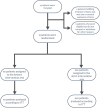Lenient rate control versus strict rate control for atrial fibrillation: a statistical analysis plan for the Danish Atrial Fibrillation (DanAF) randomized clinical trial
- PMID: 37005636
- PMCID: PMC10068144
- DOI: 10.1186/s13063-023-07247-7
Lenient rate control versus strict rate control for atrial fibrillation: a statistical analysis plan for the Danish Atrial Fibrillation (DanAF) randomized clinical trial
Abstract
Background: A key decision in the treatment of atrial fibrillation is choosing between a rhythm control strategy or a rate control strategy as the main strategy. When choosing rate control, the optimal heart rate target is uncertain. The Danish Atrial Fibrillation trial is a randomized, multicenter, two-group, superiority trial comparing strict rate control versus lenient rate control in patients with either persistent or permanent atrial fibrillation at inclusion. To prevent bias arising from selective reporting and data-driven analyses, we developed a predefined description of the statistical analysis.
Methods: The primary outcome of this trial is the physical component score of the SF-36 questionnaire. A total of 350 participants will be enrolled based on a minimal important difference of 3 points on the physical component score of the SF-36 questionnaire, a standard deviation of 10 points, a statistical power of 80% (beta of 20%), and an acceptable risk of type I error of 5%. All secondary, exploratory, and echocardiographic outcomes will be hypothesis-generating. The analyses of all outcomes will be based on the intention-to-treat principle. We will analyze continuous outcomes using linear regression adjusting for "site," type of atrial fibrillation at inclusion (persistent/ permanent), left ventricular ejection fraction (≥ 40% or < 40%), and the baseline value of the outcome (all as fixed effects). We define our threshold for statistical significance as a p-value of 0.05 and assessments of clinical significance will be based on the anticipated intervention effects defined in the sample size and power estimations. Thresholds for both statistical and clinical significance will be assessed according to the 5-step procedure proposed by Jakobsen and colleagues.
Discussion: This statistical analysis plan will be published prior to enrolment completion and before any data are available and is sought to increase the validity of the DANish Atrial Fibrillation trial.
Trial registration: Clinicaltrials.gov NCT04542785. Registered on Sept 09, 2020.
Keywords: Atrial fibrillation; Randomized trial; Rate control; Statistical analysis plan.
© 2023. The Author(s).
Conflict of interest statement
MHO reports grants from Novo Nordic Foundation outside the submitted work. AB reports personal fees from Bayer, grants from Biotronik, personal fees from Boehringer Ingelheim, personal fees from Bristol-Myers Squibb, personal fees from MSD, and grants from Theravance, outside the submitted work. UD reports a research grant from Bayer and personal fees from Pfizer, outside the submitted work. HD reports grants from the innovation fund of Grand solutions with the Danish company Cortrium APS as one of the partners and a subcontract with the Danish company Visikon APS, with funding from Danida Research Center, both outside the submitted work. All other authors report no known competing interests.
References
-
- Hindricks G, et al. 2020 ESC Guidelines for the diagnosis and management of atrial fibrillation developed in collaboration with the European Association for Cardio-Thoracic Surgery (EACTS): The Task Force for the diagnosis and management of atrial fibrillation of the European Society of Cardiology (ESC) developed with the special contribution of the European Heart Rhythm Association (EHRA) of the ESC. Eur Heart J. 2020;42(5):373–498. doi: 10.1093/eurheartj/ehaa612. - DOI - PubMed
Publication types
MeSH terms
Associated data
LinkOut - more resources
Full Text Sources
Medical


